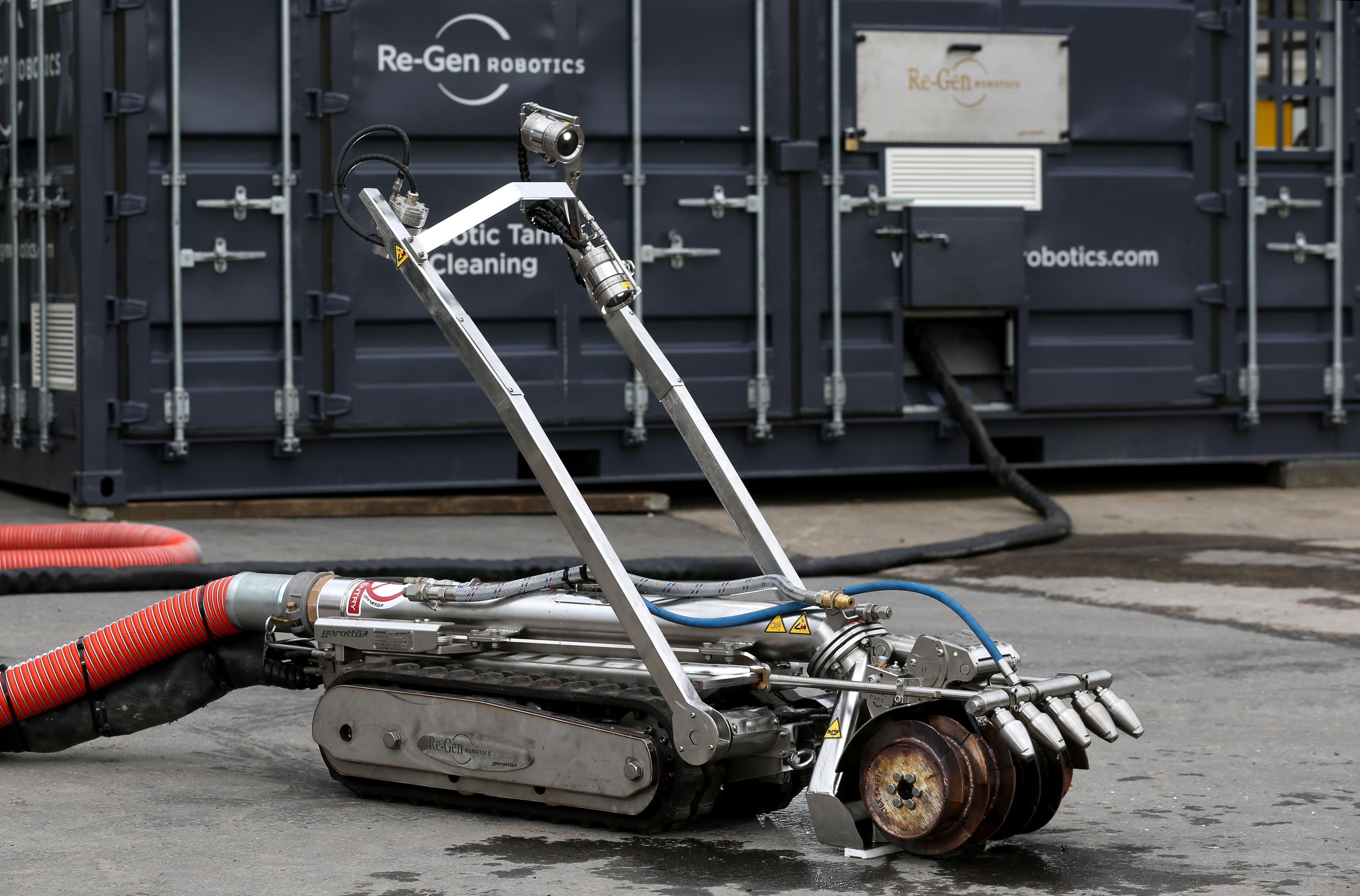
A safe and efficient solution for the future of tank cleaning
Tank cleaning of all tanks entails efficient and reliable cleaning methods and technology. Inefficient cleaning can result in product contamination, loss of man-hours, and revenue. The cost of failure can be enormous so operators of oil refineries and tank farms can be highly reluctant to consider innovative but more efficient methods of cleaning.
The oil & gas sector has historically been more risk averse and slow to adopt change, than many other sectors. But with no-man entry tank cleaning, stakeholders are being offered a viable alternative.
Using remote-controlled autonomous robotic tank cleaning systems reduces water consumption, chemical usage, energy consumption and the time taken in tank cleaning applications, without compromising overall cleaning effectiveness.
A good understanding of these cost-effective solutions and optimisation of each of the elements during cleaning will generally increase the overall efficiency of the tank clean and reduce its associated costs.
A critical element to achieve an effective tank clean is the mode of cleaning and the dislodgement and disposal or reclamation of sludge and debris. The pressure of the wash fluid coming from the cleaning nozzles is vital for an efficient clean and the power of the ADR tanker suction can cut the cleaning time by more than half.
Companies like Re-Gen Robotics are shifting the dial – industry players are now being convinced of the financial viability of no man entry tank cleaning services and are now adopting them rapidly.
A core part of its success is the fact that it allows customers to minimise cost for cleaning because the tank is turned around quickly and more efficiently.
It should also be obvious how a reduction in the time spent physically cleaning the tank consequently reduces water consumption. The shorter the cleaning cycle, the less water will be used. Reducing water usage is a key driver for many businesses because it is an easy way to measure efficiency.
The cost of using water is often under appreciated. It represents a raw utility bill cost per m3 of water used and there are costs to filtering and sanitising of recycling sludge. If terminal operators can reduce water usage in tank cleans, they can lower pump running costs (electricity), lower maintenance costs, and generate a longer lifetime for the pump and its parts.
As the cost of energy and water are both increasing, and likely to continue in that direction, reductions in water usage have significant financial benefits to any operator. Additionally, the environmental benefits of using less water can only be good for an organisation’s environmental, social and governance (ESG) credentials.
Time is also money, so the time spent on maintenance and cleaning, whilst necessary, nevertheless represents tank downtime. This is time that the tank can’t be used for storing product. The cost associated with this downtime can vary greatly depending on the function and product stored, but in almost all cases a reduction in tank cleaning time will have a direct financial benefit.
What terminal operators are looking for is a leading innovator delivering tank cleaning solutions that give them confidence in the safety and compliance in the integrity of their assets. All this while reducing their costs and risks can be achieved today, by using a trusted, sustainable solution for no man entry tank cleaning.
For use in all tank cleans, Re-Gen Robotics provides safe, efficient tank cleaning solutions that are smarter and more cost effective than other tank cleaning options. Its unrivalled technical knowledge base, proven track record and numerous awards demonstrate a firm that is maximising opportunities at every turn, illustrated by its continual growth in clients and revenue year on year. The company is driven by people with key understanding in key technologies.
While the industry is beginning to pick up and shift towards adopting this service as their preferred method, Re-Gen Robotics is continuing to build up its portfolio of satisfied clients whose performance data is revealing genuine efficiency gains.
From arrival onsite, to the robot entering the tank is approximately two hours.
As well as this the job can be done up to 60% faster in comparison to traditional methods.
The substantial reduction in downtime of tanks leads to increased efficiencies for the client. The robotic cleaning system helps ensure production doesn’t slow, getting tanks ready up to 50% faster than human cleaning crews.
Re-Gen Robotics has been instrumental in moving the sector on from dangerous, outdated and time-consuming processes, and enables oil terminal operators to safely and efficiently manage their tank cleaning schedule.
To date all Re-Gen Robotics’ tank cleans have been performed on time, within budget and without environmental incidents or statutory environmental liabilities. Waste is properly managed, to minimise its potential to cause harm to the environment and in accordance with stringent regulations.
During the performance of all tank cleaning operations, generated waste material is either treated and returned to the tank or transported from the site using an ADR tanker and is safely treated in an authorised, licensed facility.
Re-Gen Robotics’ experience encompasses every tank design and type of material: crude, petrochemical, black oil and white oil, and the company is commonly engaged in finishing projects where other tank cleaning service providers have failed.
The following case studies demonstrate the variety of tanks and materials that Re-Gen Robotics can clean, the challenges encountered, the solutions implemented, and the benefits conveyed.
SHELL UK OIL PRODUCTS LTD, SHELL HAVEN TERMINAL
Re-Gen Robotics was commissioned by Shell UK Oil Products Ltd to clean two 30m floating roof, Jet A1 fuel storage tanks at the Shell Haven Terminal.
Challenge
Both tanks had a resin lining applied to the floor and 1m up the tank walls.
Solution
Magnetic tracks were removed from service for lined tanks and plain rubber tracks were fitted to the robot to protect the resin flooring.
Tonnage of sludge removed: 12-14 Tonnes removed from each tank No. of man hrs eliminated onsite: 448 hrs per tank No. of robotic hrs onsite: Robot Crew = 90 hrs per tank
Tonnage of water utilised: 2 Tonnes of water for each tank Difference of hrs it would have taken a manned clean: CSE Clean would have taken 8 days, Robotic clean took 3 days Less paperwork and permits necessary - medium risk contractor No requirement to spade tanks No requirement for capital outlay – scaffolding, cranage and vacuum jetting provided No requirement for standby rescue team
Conclusion
Overall feedback from Shell was very positive. These were the first tanks to be completely cleaned and inspected by Shell, worldwide, without the need for human presence in the tanks.
Following this initial project, Re-Gen Robotics has been commissioned to clean more tanks at the Shell Haven Terminal.
Shell committed to end manned tank cleaning across its operations by the end of 2022.
VERMILION GAS TERMINAL Re-Gen Robotics was commissioned to clean three 15m tanks at a gas terminal, which refines and purifies gas from a gas field in the west coast of Ireland.
The first tank scheduled to be cleaned contained methanol and the remaining tanks contained condensate, a low-density mixture of hydrocarbon liquids present, as gaseous components in raw natural gas.
Challenges
Tanks were resin lined. Tanks contained a large amount of internal furniture including aluminium legs, skim arms and floating pontoons. Entry manholes were raised slightly higher than standard tanks and there was a great deal of piping situated on the ground around the tanks’ exteriors. Initial inspection verified that the height of the tank was considerably lower than most tanks and therefore it would be necessary to restrict the height of the telescopic camera bracket.
Solutions
Plain rubber tracks were fitted to the robot to protect the resin flooring. An offset suction head was deployed to clean around heating coils. The low-profile tool can access under pipes and has the ability to remove waste from below floor level. It can operate offset on the left, right and straight-ahead positions. This tool alone can decrease tank cleaning time by 10-12%. It was noted that a portable raised platform would be required to allow the robot to pass freely over the exterior pipework, to meet the manhole entry ramp. The platform was supplied by the client and was also used for the second tank clean. Arrangements were immediately put in place to fit rubber stoppers around the ATEX camera and restrict the height of the camera bracket with a length of chain.
Tonnage of sludge removed: 7 Tonnes removed from each tank No. of man hrs eliminated onsite: 280 hrs per tank No. of robotic crew hrs onsite: 45 hrs per tank
Tonnage of water utilised: 1.5 Tonnes of water for each tank Difference of hrs it would have taken a manned clean: CSE Clean would have taken 5 days, Robotic clean took 1.5 days Less paperwork and permits necessary – Medium risk contractor No requirement to spade tanks No requirement for capital outlay – scaffolding, cranage and vacuum jetting provided No requirement for standby rescue team
Conclusion
The speed and efficiency of the tank cleans exceeded Vermilion’s expectations, by finishing ahead of schedule and by significantly reducing the amount of tank downtime. Re-Gen Robotics continues to clean tanks for Vermilion.
PHILLIPS 66 HUMBER REFINERY
Re-Gen Robotics carried out the first no man entry crude oil tank clean for Phillips 66 Limited’s Humber Refinery.
Some 20 per cent of all UK petroleum products come from their Humber Refinery.
Re-Gen Robotics was commissioned to clean a 50m fixed roof, cone-up floor crude oil (black) tank.
Challenges
Exact tank furniture details and volume of sludge were unspecified. The volume of waste inside the tank was understood to be approximately 135 Tonnes and the product temperature was ambient. The tank had numerous steam coils which the robot was required to navigate around.
Solutions
The robot is fully submersible and has an auger system located at the front which breaks down heavy sludge, without the requirement to use water, thereby generating less waste. The sludge was then extracted by an ADR certified jet/vac tanker with a 4,800 C/ m3 per hour vacuum capacity. The robot uses an offset suction head to clean around heating coils. The low-profile tool can access under pipes and has the ability to remove waste from below floor level. It can operate offset on the left, right and straight-ahead positions. This tool alone can decrease tank cleaning time by 10-12%. Tonnage of sludge removed from tank: 536 Tonnes removed from tank No. of man hrs eliminated onsite: 12,160 hrs No. of robotic crew hrs onsite:1,520 hrs Tonnage of water utilised – 92 Tonnes Difference of hrs it would have taken a manned clean: x6 man CSE Clean would have taken 95 days, Robotic clean took 43 days Less paperwork and permits necessary - medium risk contractor No requirement to spade tanks No requirement for capital outlay – scaffolding, cranage and vacuum jetting provided No requirement for standby rescue team
Conclusion
Phillips 66 acknowledged the success of the no man entry tank clean because the system could be adapted to suit their individual needs and time frames.
Following the initial contract, Re-Gen Robotics was commissioned to clean a further three tanks at the site.
As more terminal operators see the benefits using no man entry robotic tank cleaning to tackle their oil tanks, Re-Gen Robotics’ order book continues to grow.
The service provided is straightforward and completely transparent. Any challenges that arise are dealt with swiftly, with full transparency and with the appreciation that the efficiency of the clean is crucial to planning schedules so that the tanks can be brought back into operation within agreed timeframes.
The company is delivering high value contracts across the UK and are looking forward to expanding their services to new customers in Europe and the USA.
For further information visit www.regenrobotics.com
